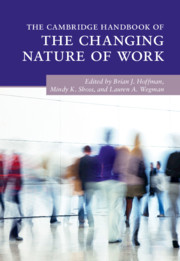Book contents
- The Cambridge Handbook of the Changing Nature of Work
- The Cambridge Handbook of the Changing Nature of Work
- Copyright page
- Contents
- Figures
- Tables
- Contributors
- Part I Introduction to the Changing Nature of Work
- Part II What Has Changed?
- 4 Changes in Technology
- 5 The Changing Nature of Work
- 6 Changes in Occupations, Jobs, and Skill Polarization
- 7 Changes in the Legal Landscape
- 8 The Rise and Decline of Organized Labor in the United States
- 9 Changes in Organizational Income Inequality
- 10 Work and Employment in Fluid Organizational Forms
- 11 Changes in Worker Demographics
- 12 Generational Changes in Personality, Values, and Abilities
- 13 Changes in Work Behavior Patterns
- Part III Implications for Talent Management and Impact on Employees
- Index
- References
10 - Work and Employment in Fluid Organizational Forms
from Part II - What Has Changed?
Published online by Cambridge University Press: 02 April 2020
- The Cambridge Handbook of the Changing Nature of Work
- The Cambridge Handbook of the Changing Nature of Work
- Copyright page
- Contents
- Figures
- Tables
- Contributors
- Part I Introduction to the Changing Nature of Work
- Part II What Has Changed?
- 4 Changes in Technology
- 5 The Changing Nature of Work
- 6 Changes in Occupations, Jobs, and Skill Polarization
- 7 Changes in the Legal Landscape
- 8 The Rise and Decline of Organized Labor in the United States
- 9 Changes in Organizational Income Inequality
- 10 Work and Employment in Fluid Organizational Forms
- 11 Changes in Worker Demographics
- 12 Generational Changes in Personality, Values, and Abilities
- 13 Changes in Work Behavior Patterns
- Part III Implications for Talent Management and Impact on Employees
- Index
- References
Summary
This chapter analyzes how work and employment are shaped within a landscape marked by organizational innovation and, more often than not, even by the fundamental transformation of formal organizations. Even large organizations are increasingly adopting what some have called “post-bureaucratic” forms. The post-bureaucratic organizational landscape is marked by three trends with the aim of achieving even more fluidity in organizations: temporariness, plurality, and partiality. With regard to these three aspects, we argue that work and employment, often intermediated with the help of agencies of all sorts, are increasingly integrated in networked processes of interorganizational value creation.
Keywords
- Type
- Chapter
- Information
- The Cambridge Handbook of the Changing Nature of Work , pp. 214 - 236Publisher: Cambridge University PressPrint publication year: 2020
References
- 4
- Cited by

